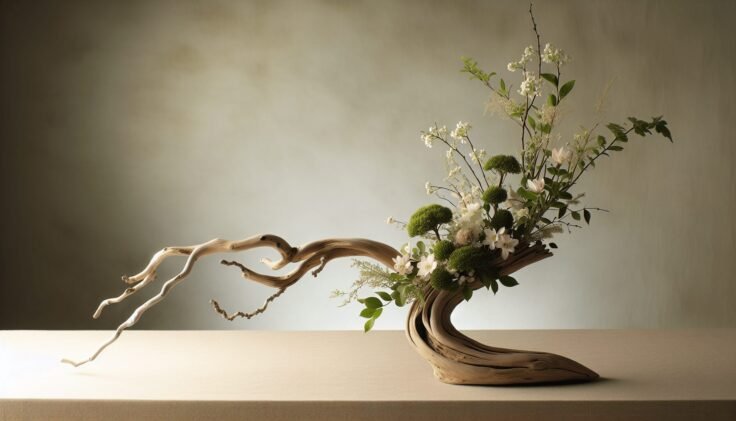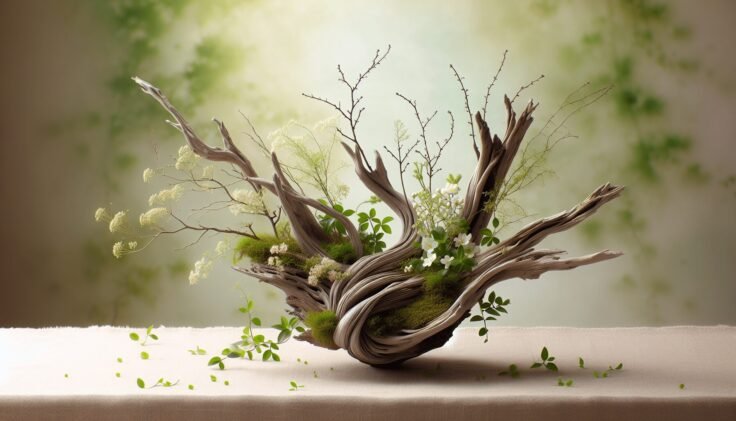Have you ever wondered about the fascinating evolution and artistry of floral arrangements? Driftwood Ikebana, a captivating Japanese art form, marries the organic beauty of driftwood with the precise elegance of floral composition. This unique artistic expression offers a connection to nature, celebrating simplicity, balance, and harmony. Let’s navigate this world and discover how you can bring this serene beauty into your own space.

The Origin and Philosophy of Ikebana
Ikebana, sometimes referred to as the Japanese art of flower arrangement, dates back to the 7th century. It originally began as religious offerings in Buddhist temples but has now evolved into a highly respected art form worldwide. More than just placing flowers in a container, it is about appreciating the relationship between materials, the container, and the surrounding space.
The Zen Connection
At its core, Ikebana emphasizes minimalism and restraint, focusing not on the quantity of flowers but on the harmonious integration of all elements. Many who practice Ikebana describe it as a meditative process that fosters concentration, patience, and an intimate connection with nature. Each element, including the stems, leaves, flowers, and even buds, carries significance, reflecting the changing seasons and the transient beauty of life.
Driftwood as a Medium
Driftwood, with its natural textures and aged appearance, provides a stunning contrast to the fresh vibrancy of flowers. Incorporating driftwood into Ikebana introduces an additional layer of depth and history to the arrangement. Each piece of driftwood tells a story, shaped by the forces of nature over time, making it the perfect complement to the ephemeral nature of flowers.
Selecting Driftwood for Ikebana
Choosing the right piece of driftwood is akin to selecting the right canvas for a painting. You should look for pieces that possess unique shapes, interesting textures, and a sense of balance. It’s crucial to consider the weight and stability of the wood, as it has to support plant materials without toppling over. Remember, the driftwood is a crucial part of your arrangement, not merely a base but an integral component of the overall design.
| Aspect | Consideration |
|---|---|
| Texture | Look for unique and contrasting textures that enhance the visual interest of the arrangement. |
| Shape | Opt for pieces with artistic or natural curves that can guide the flow of your design. |
| Stability | Ensure the piece can support the plant material and stand securely. |
Basic Principles of Ikebana
At first glance, Ikebana arrangements might seem effortlessly simple, but they follow strict principles rooted in precise planning and artistic intention.
Line and Balance
The philosophy of Ikebana emphasizes the beauty in asymmetry and balance. The arrangement typically comprises three main lines that symbolize ten (heaven), chi (earth), and jin (human). These lines represent the interconnectedness of all elements in the universe, with each having specific proportions to maintain harmony.
Space and Silence
The use of space is another crucial element in Ikebana. The space around and within the arrangement allows the viewer to focus on the interaction between the lines and the floral elements, enhancing the overall effect. In addition, silence plays a role, as the calmness around the structure enables true appreciation of its natural beauty.
Techniques to Master Driftwood Ikebana
Creating a driftwood Ikebana piece is both an art and a science, necessitating familiarity with certain techniques.
Securing Plant Materials
Since driftwood can be irregular, securing plant materials might require extra creativity. You might use a kenzan (pin holder), wires, or floral tape to attach the stems securely beneath or around the wood. It’s important to maintain a natural look, disguising any materials used for support as much as possible.
Creating Flow and Movement
The flow of an arrangement guides the viewer’s eye through the piece. By using the natural curves and lines of driftwood, you can enhance the movement, encouraging the eye to travel across each element of your design. Consider how your choice and placement of flowers and foliage can enhance this flow, suggesting upward or outward energy.

Choosing Plant Materials
Selecting the right plant materials is crucial in Ikebana, where every element should reflect a different season or sentiment.
Seasonal Selection
Choosing seasonal flowers and foliage ties your arrangement to a specific time and place, enhancing its significance. Spring might be expressed with blooms like cherry blossoms, while autumn could be represented through the warm hues of autumn leaves.
Contrast and Complementarity
Contrast is key—think of vibrant blooms against the subtle hues of driftwood. The differing textures of wood and petals should enhance each other, creating visual delight and layered complexity. Select plant materials that echo or softly contrast the patterns found in your chosen piece of driftwood.
Driftwood Ikebana as a Meditative Practice
Engaging in driftwood Ikebana can be a deeply meditative practice. The process invites reflection and mindfulness, encouraging you to contemplate the beauty and transient nature of life. Each creation is unique, fleeting, and representative of a moment in time.
Mindful Arranging
When you engage in Ikebana, each step invites focus and intention. From selecting the driftwood to choosing plant materials and arranging them, each phase offers an opportunity for mindful engagement, requiring attention and calm presence.
Reflection and Personal Growth
The practice of Ikebana instills patience and appreciation for simplicity, encouraging personal growth and reflection. As you refine your skills, you’ll likely find that the practice becomes a soothing ritual that helps instill peace and clarity in your daily life.
Bringing Driftwood Ikebana into Your Space
Incorporating driftwood Ikebana into your home can transform your living space, becoming a focal point of calm and natural beauty.
Creating a Focal Point
Place your driftwood Ikebana arrangement where it can be appreciated, perhaps on a dining table or in an entryway. It will serve as a constant reminder of the beauty found in nature and the flow of life.
Integrating with Your Decor
Consider how the colors and shapes in your arrangement complement your overall decor. Incorporating elements of nature indoors can create a seamless transition between your indoor environment and the natural world.
Driftwood Ikebana Workshops and Learning Opportunities
For those eager to delve further into this serene art form, workshops and classes offer guidance and inspiration.
Finding Local Workshops
Check local botanical gardens, cultural centers, or art institutions for classes. Engaging with a community of like-minded enthusiasts can enhance your understanding and appreciation of the craft.
Online Resources
Numerous online resources are also available, from detailed tutorials to virtual workshops where skilled practitioners share their knowledge and creative insights. These resources can provide a convenient and flexible way to start your journey in driftwood Ikebana.
Conclusion
Driftwood Ikebana is not only an art form but a means of reconnecting with nature’s organic beauty and impermanence. By incorporating driftwood, each arrangement tells a story, offering a unique perspective through its blend of history, artistry, and natural harmony. Whether you’re a seasoned florist or a beginner eager to explore new creative avenues, driftwood Ikebana welcomes you to experience the meditative tranquility of this time-honored craft. Embrace the opportunity to express your connection to nature through your unique arrangements and enrich your living spaces with this peaceful, natural art form.